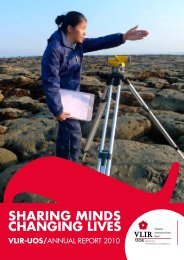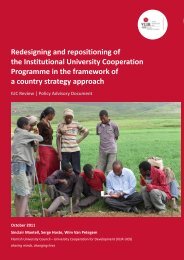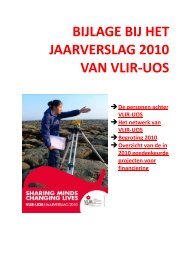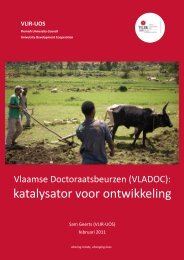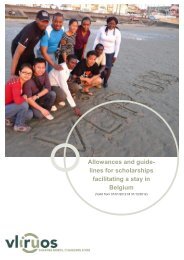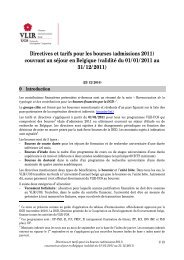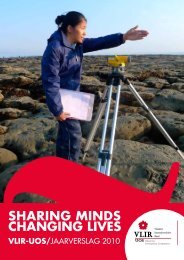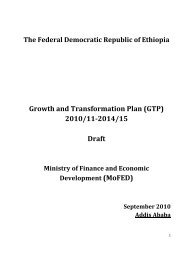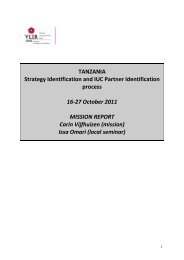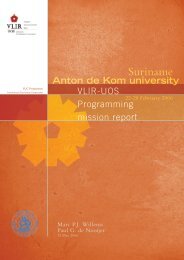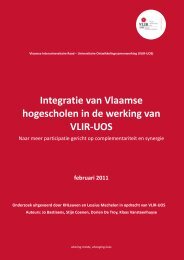Education Sector Development Program - VLIR-UOS
Education Sector Development Program - VLIR-UOS
Education Sector Development Program - VLIR-UOS
You also want an ePaper? Increase the reach of your titles
YUMPU automatically turns print PDFs into web optimized ePapers that Google loves.
<strong>Education</strong> <strong>Sector</strong> <strong>Development</strong> <strong>Program</strong> IV<br />
<strong>Program</strong> matrix<br />
Strategies and component activities Indicator/target *<br />
Component 1 Access to primary education<br />
universalized by 2008, through a continued<br />
expansion of formal primary education and when/<br />
wherever necessary through ABE centers<br />
Increasing the number of classrooms in primary<br />
and ABECs<br />
Expanding the number of primary schools with<br />
emphasis on reducing distance between schools<br />
and pupils’ homes, particularly at second cycle<br />
primary<br />
Increasing the number of teachers, facilitators and<br />
leaders<br />
Transforming the existing ABECs to regular schools<br />
Opening, where necessary, new ABE services<br />
Providing necessary financial and material<br />
resources<br />
Component 2 Inequalities in access to primary<br />
education reduced with special attention to girls,<br />
youngsters from rural areas and children from<br />
emerging regions and underserved areas<br />
Opening multi-grade classes as a means of<br />
integrating and maintaining children of scarcely<br />
populated areas in school<br />
Opening mobile schools and Para-boarding<br />
schools for meeting the needs of pastoralist and<br />
semi-pastoralist students<br />
NIR will reach 100%<br />
Drop-out rate through out primary education and<br />
in ABEC will reach 1. 0%<br />
The repetition rate throughout primary education<br />
will decrease to 1.0%<br />
Transition rate ABEC to grade 5 will reach 80%<br />
The GER for grades 1-4 will reach 125% for both<br />
boys and girls<br />
The NER for grades 1-4 will reach 95% for both<br />
boys and girls<br />
The GER for grades 5-8 will reach 100% for both<br />
boys and girls<br />
The NER for grades 5-8 will reach 80% for both<br />
boys and girls<br />
The GER for grades 1-8 will reach 113.4% for both<br />
boys and girls<br />
GPI for GER both for primary 1-4 and 5-8 will be 1<br />
No of classrooms<br />
No of new classrooms constructed<br />
% of students walking more than three km on the<br />
average<br />
No of teachers and facilitators<br />
No of newly recruited teachers and facilitators<br />
% of female teachers<br />
No of ABECs transformed to formal schools<br />
No of ABECs phased out<br />
No of newly opened ABE services<br />
% of primary education budget in overall education<br />
budget<br />
GPI for NIR and for NER for grades 1-4 will reach<br />
1.00<br />
The GER for grades 1-8 in Afar will reach 98% in<br />
2014/15<br />
The GER for grades 1-8 in Somali will reach 100%<br />
in 2014/15<br />
Enrolment rates for youngsters from rural areas<br />
and for children from emerging regions and<br />
underserved areas will increase more rapidly than<br />
the average<br />
No of schools with multigrade classes<br />
% of teachers trained in teaching multigrade<br />
classes<br />
Number of mobile and of para-boarding schools<br />
Share of primary enrolment in mobile and paraboarding<br />
schools<br />
* See comment on indicators and/or targets at the beginning of chapter 3.<br />
35



